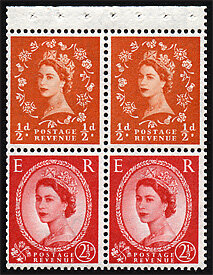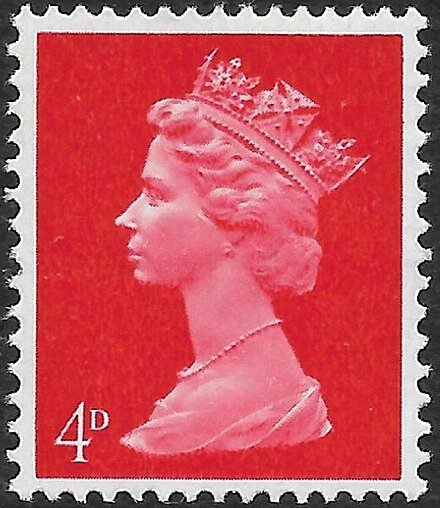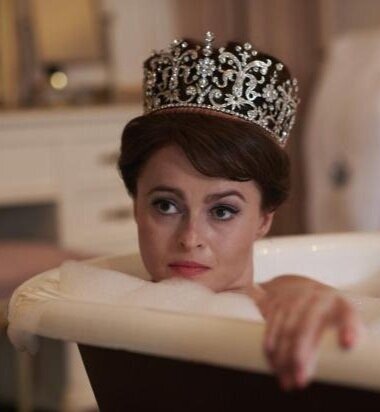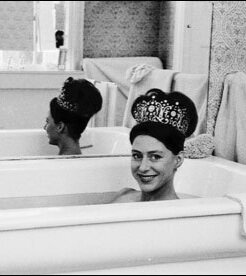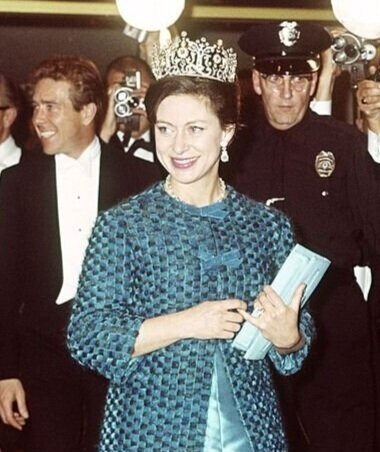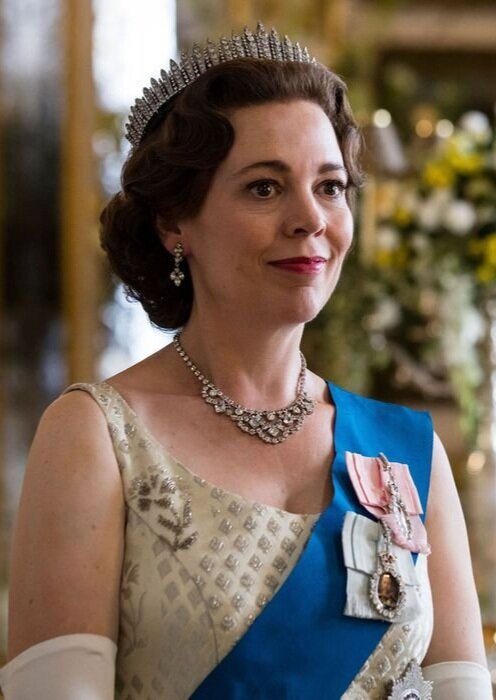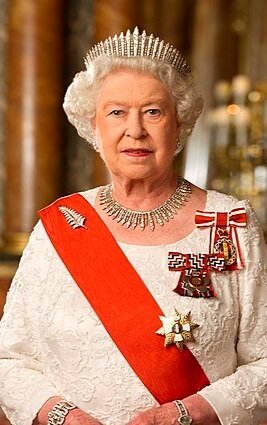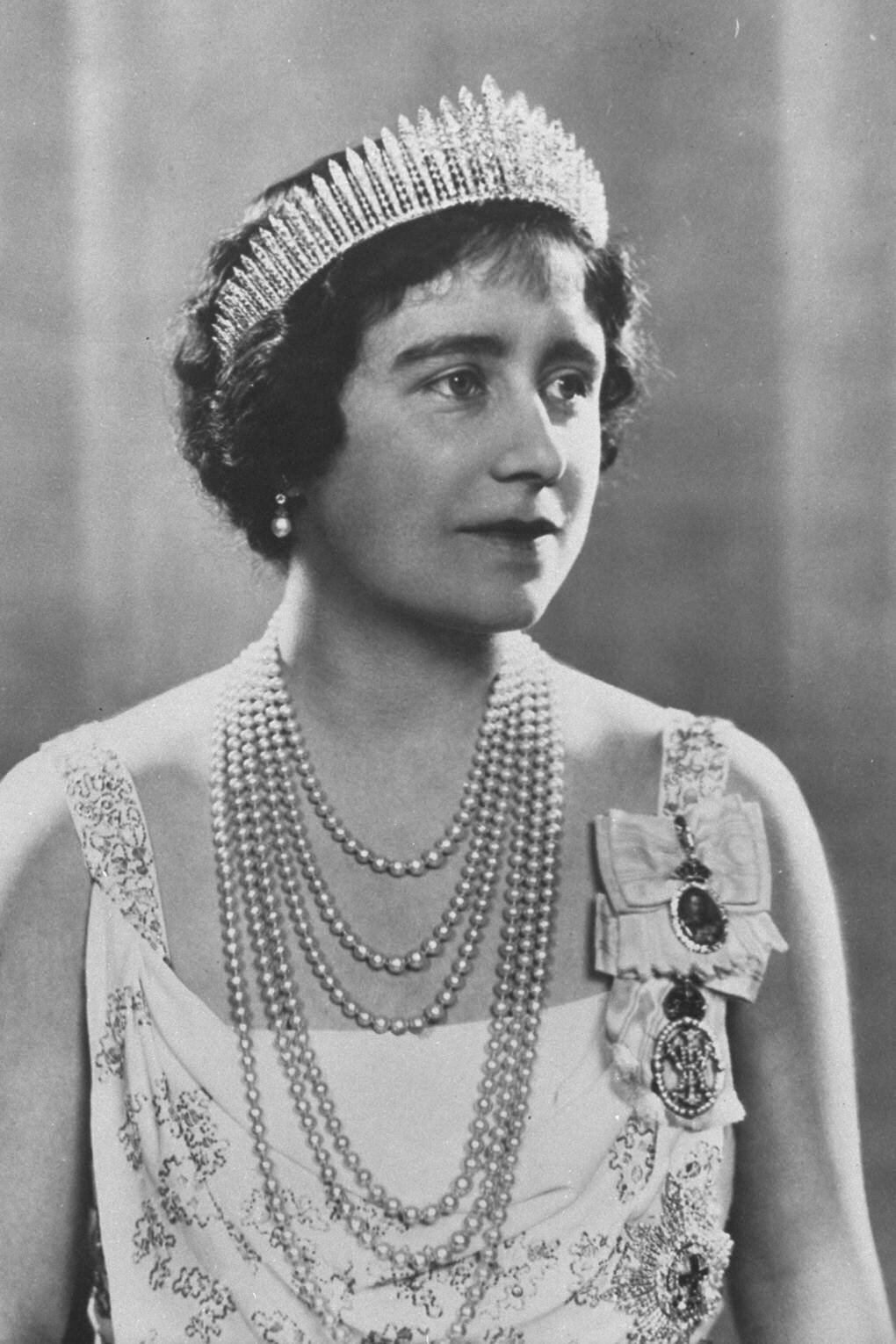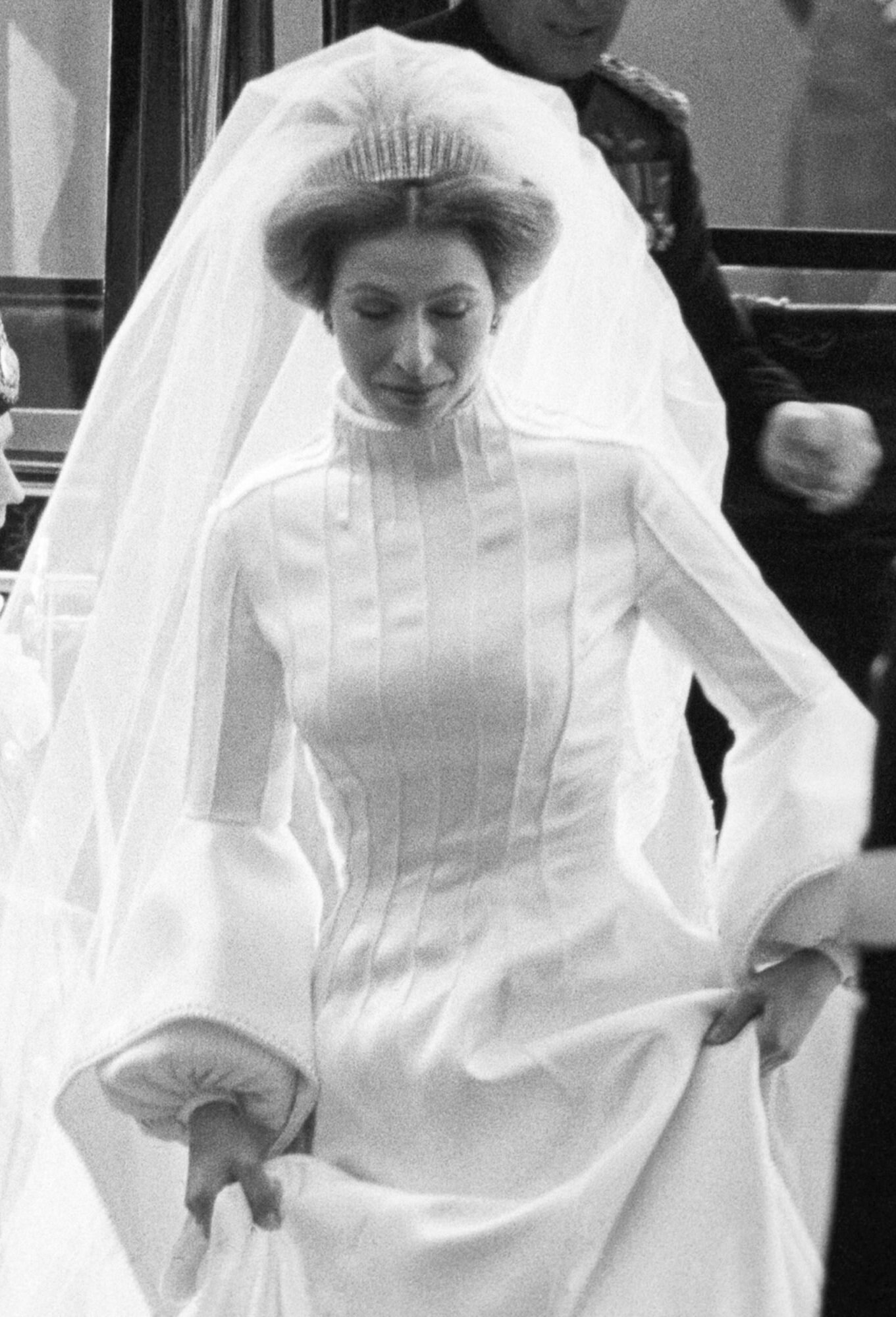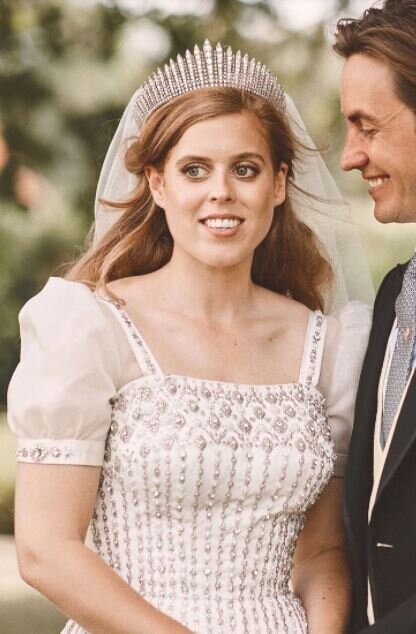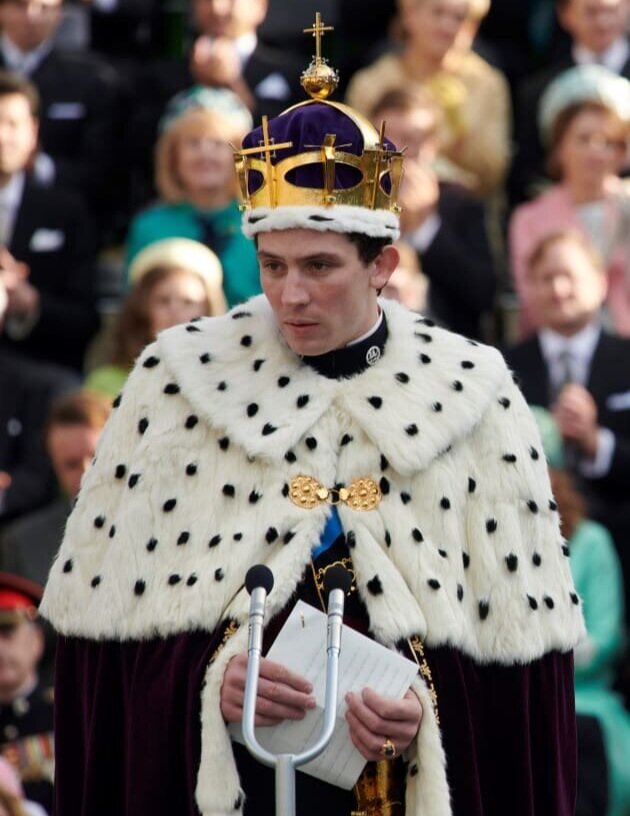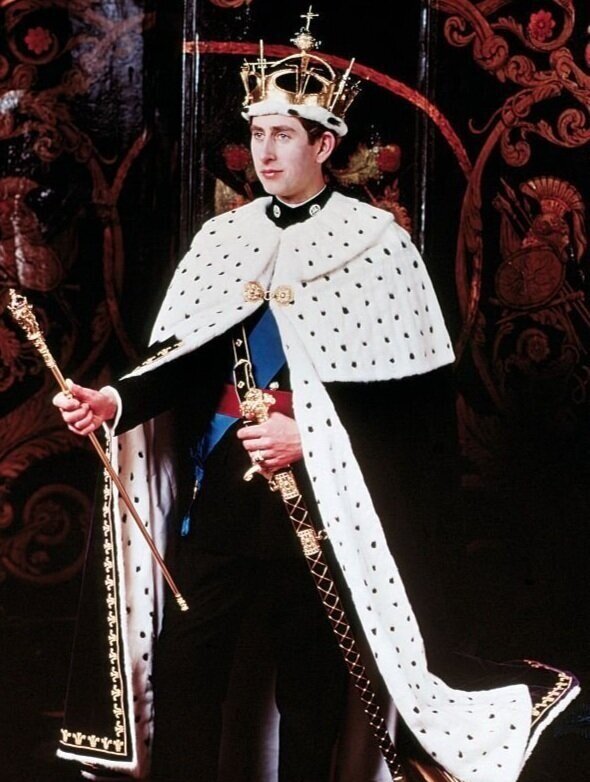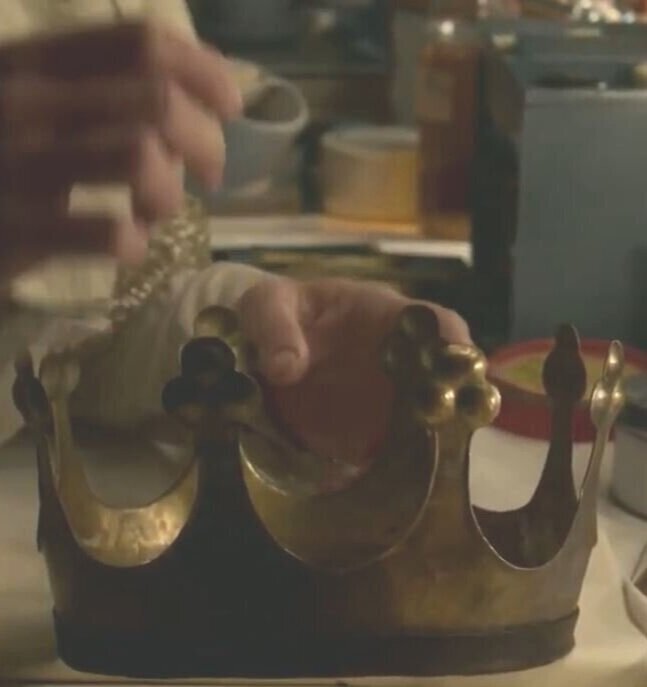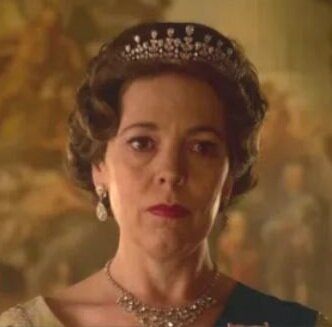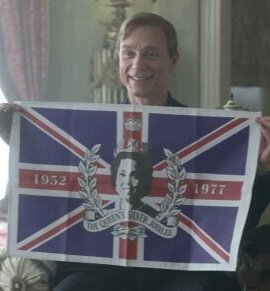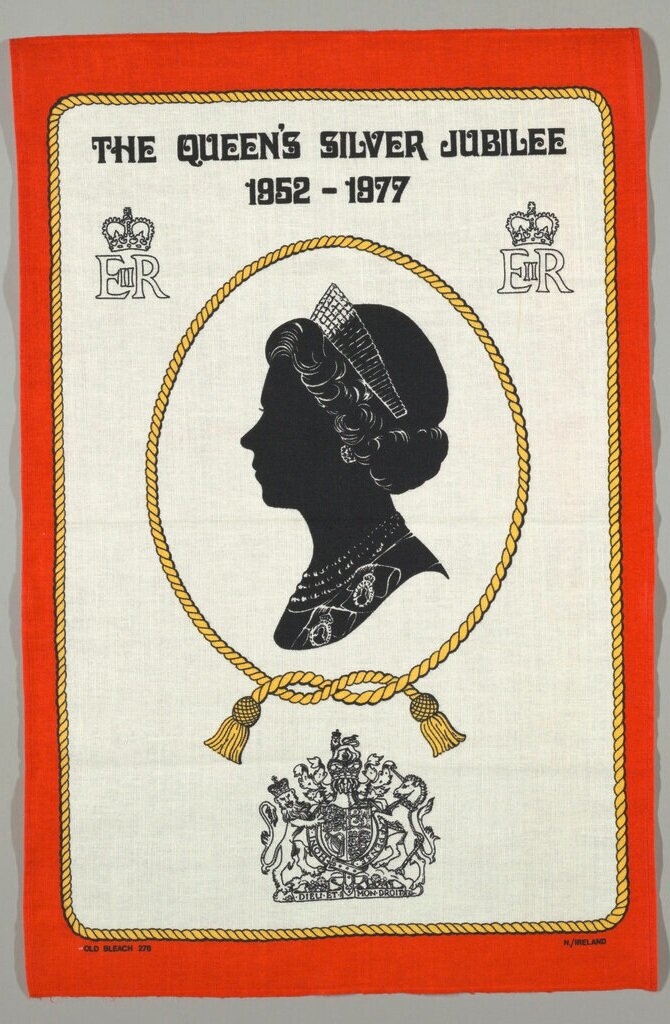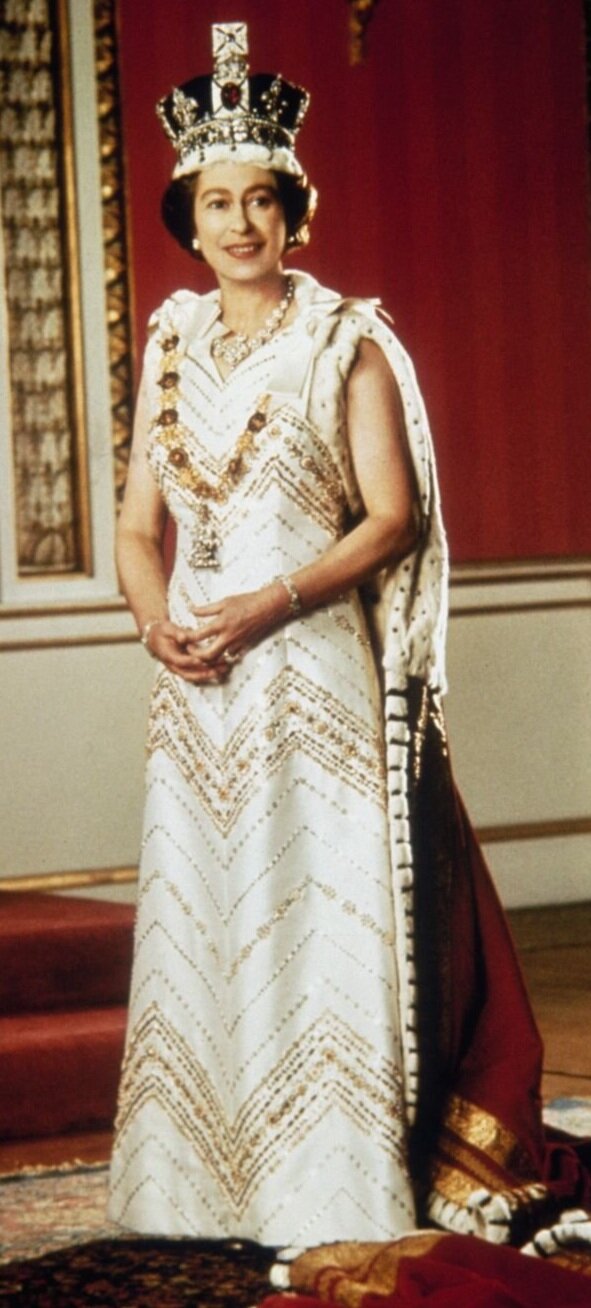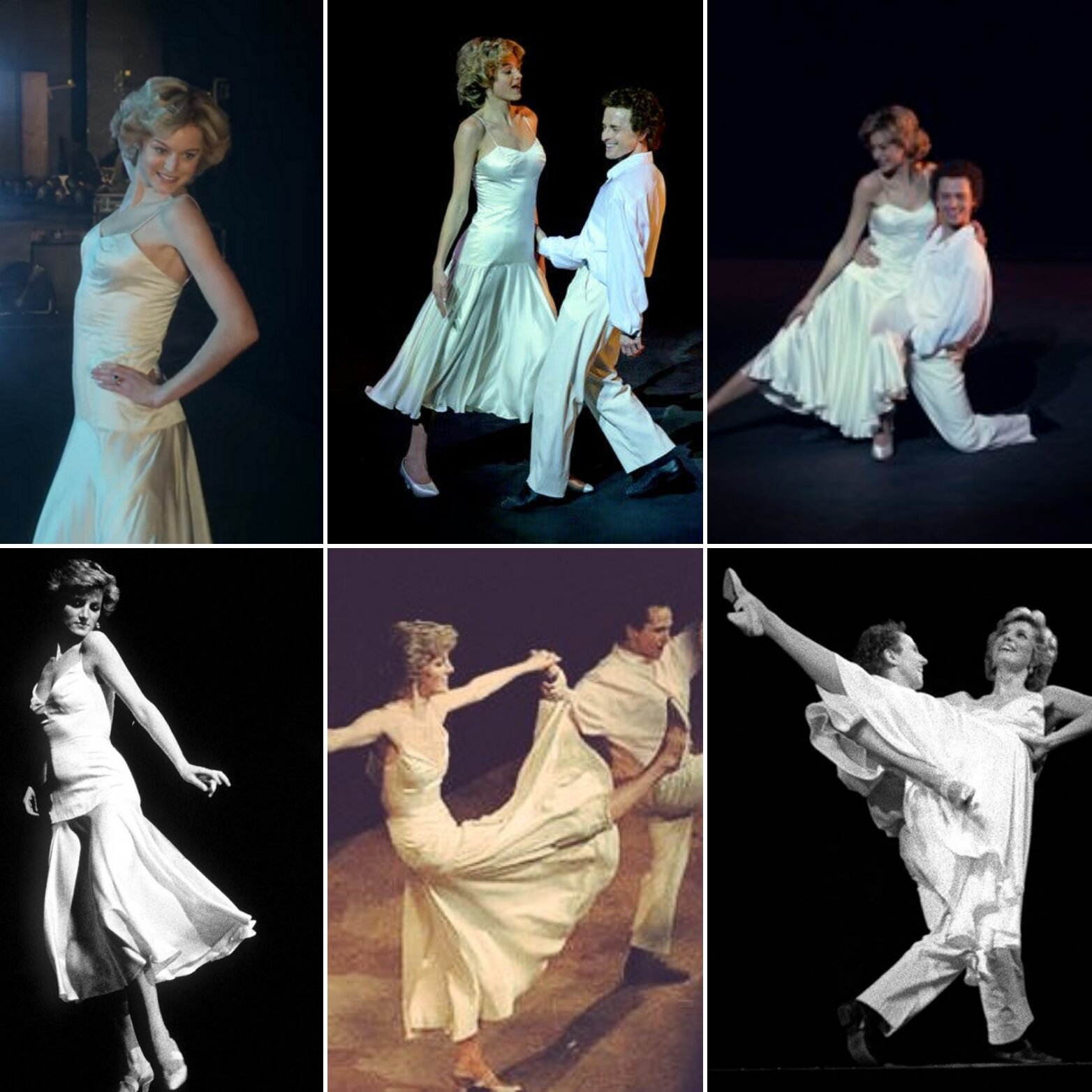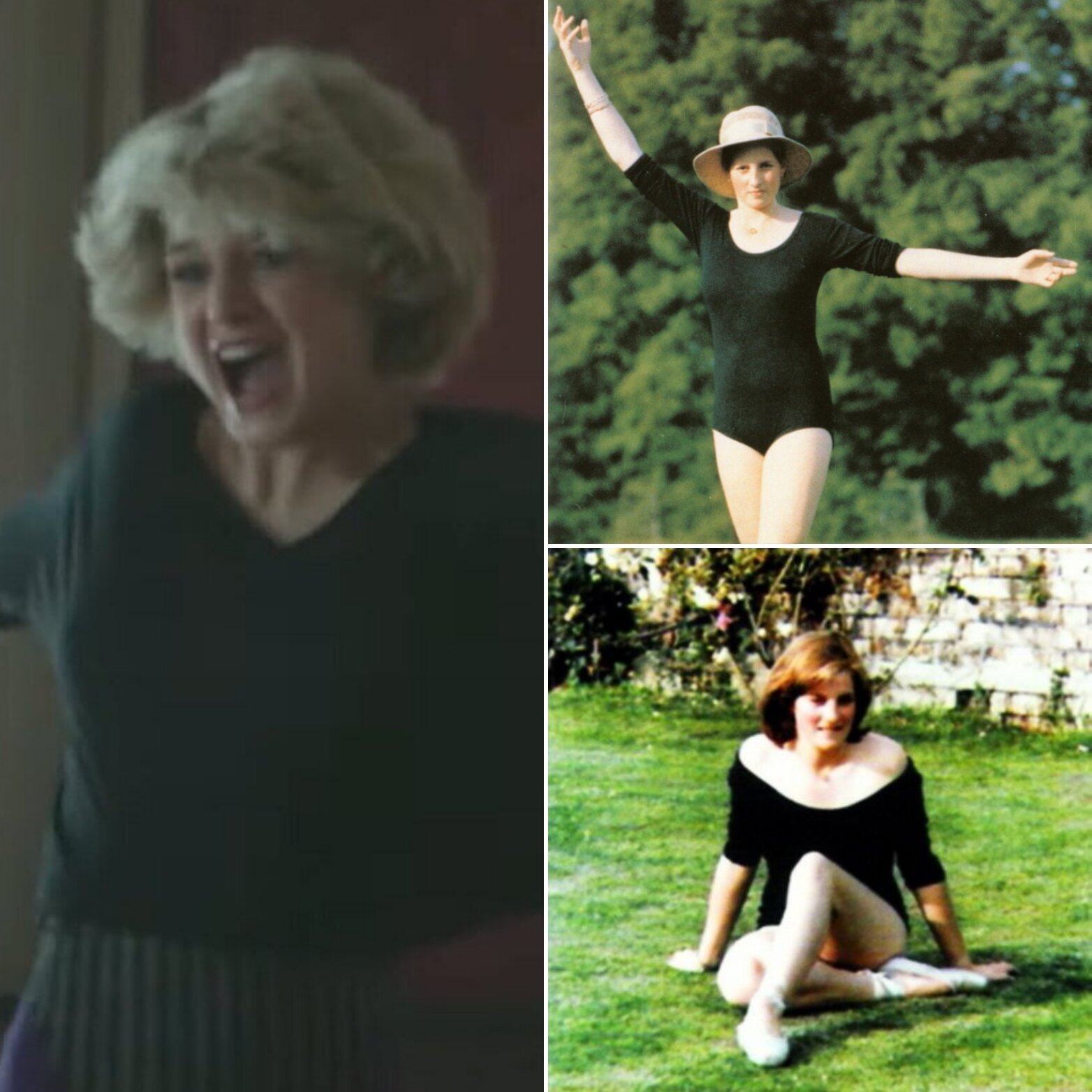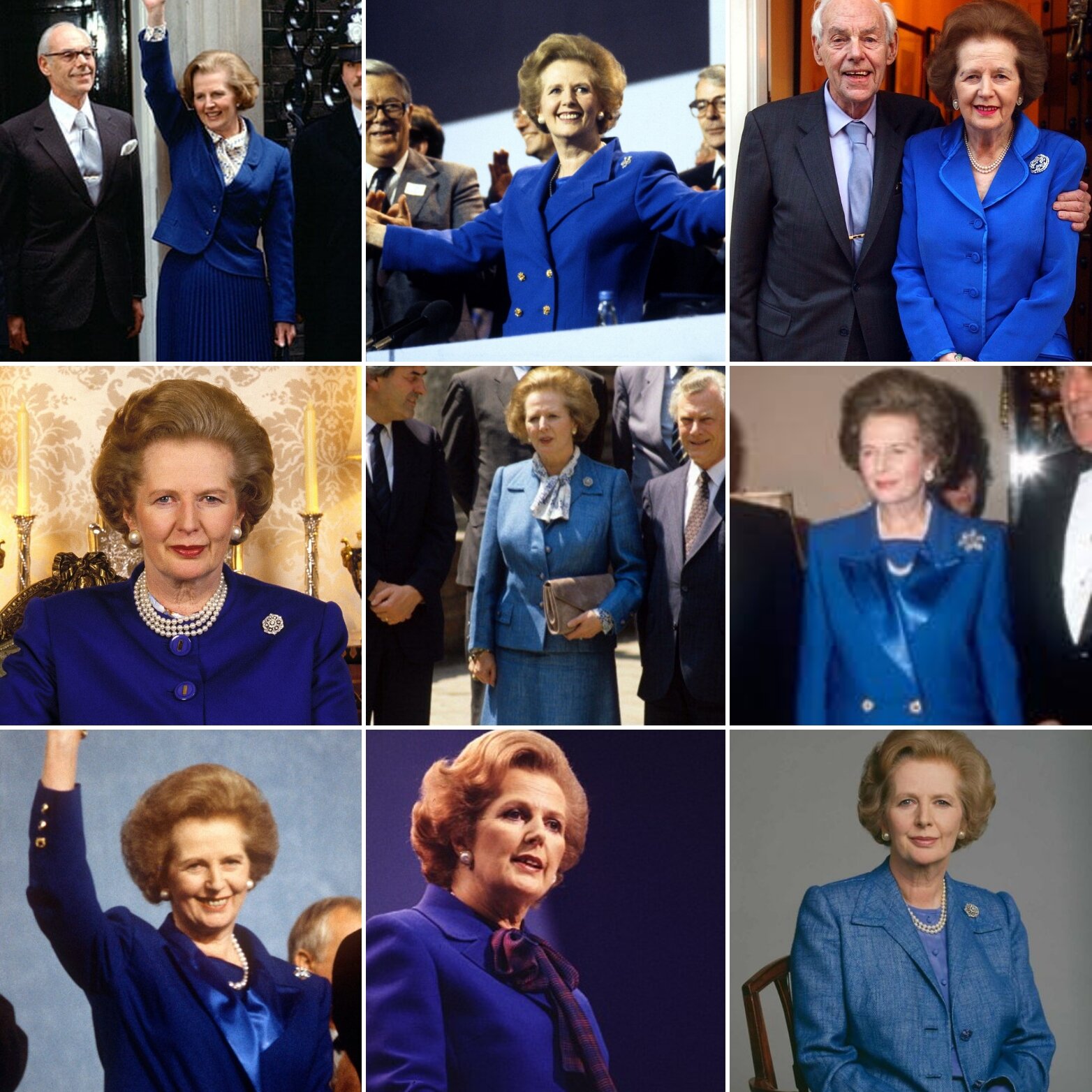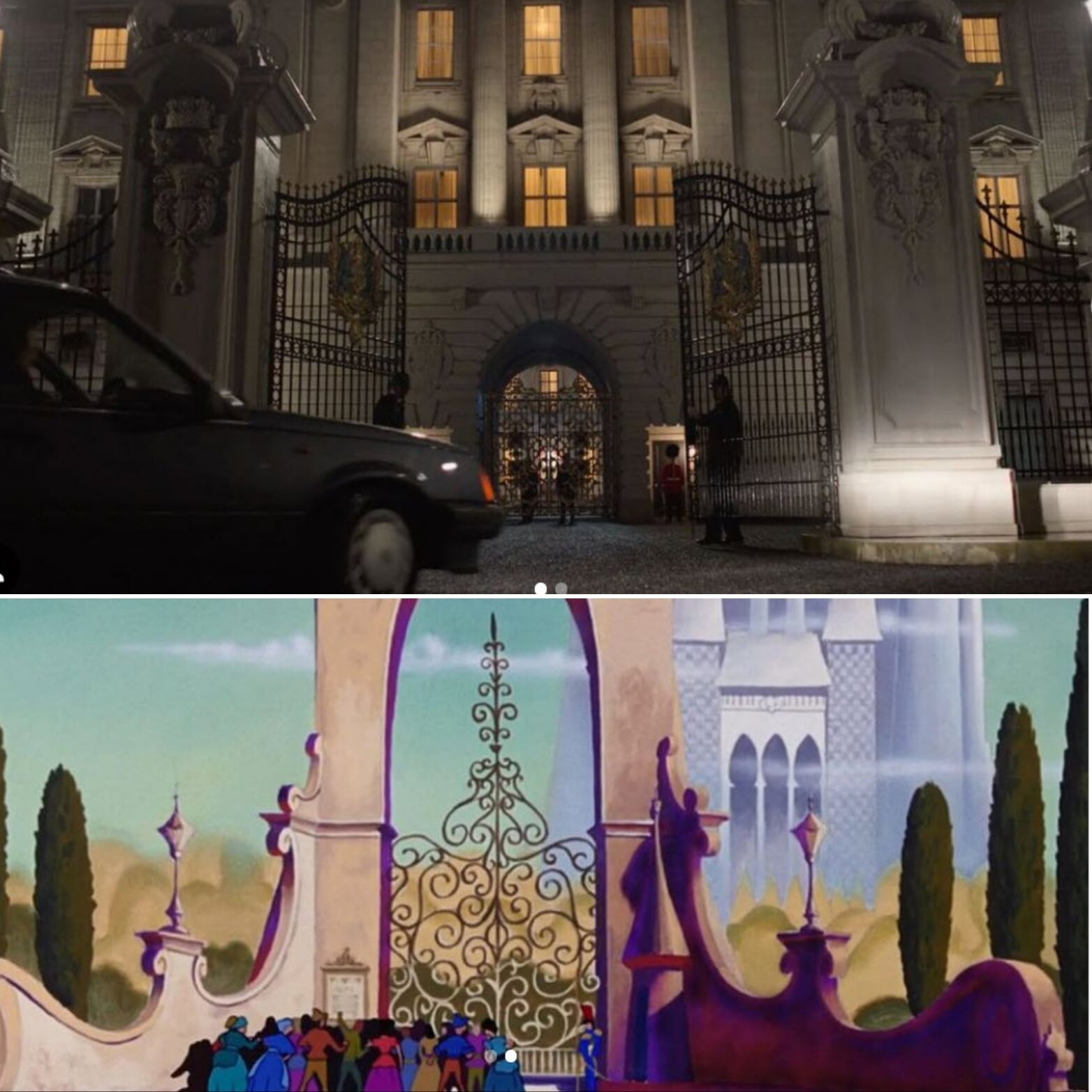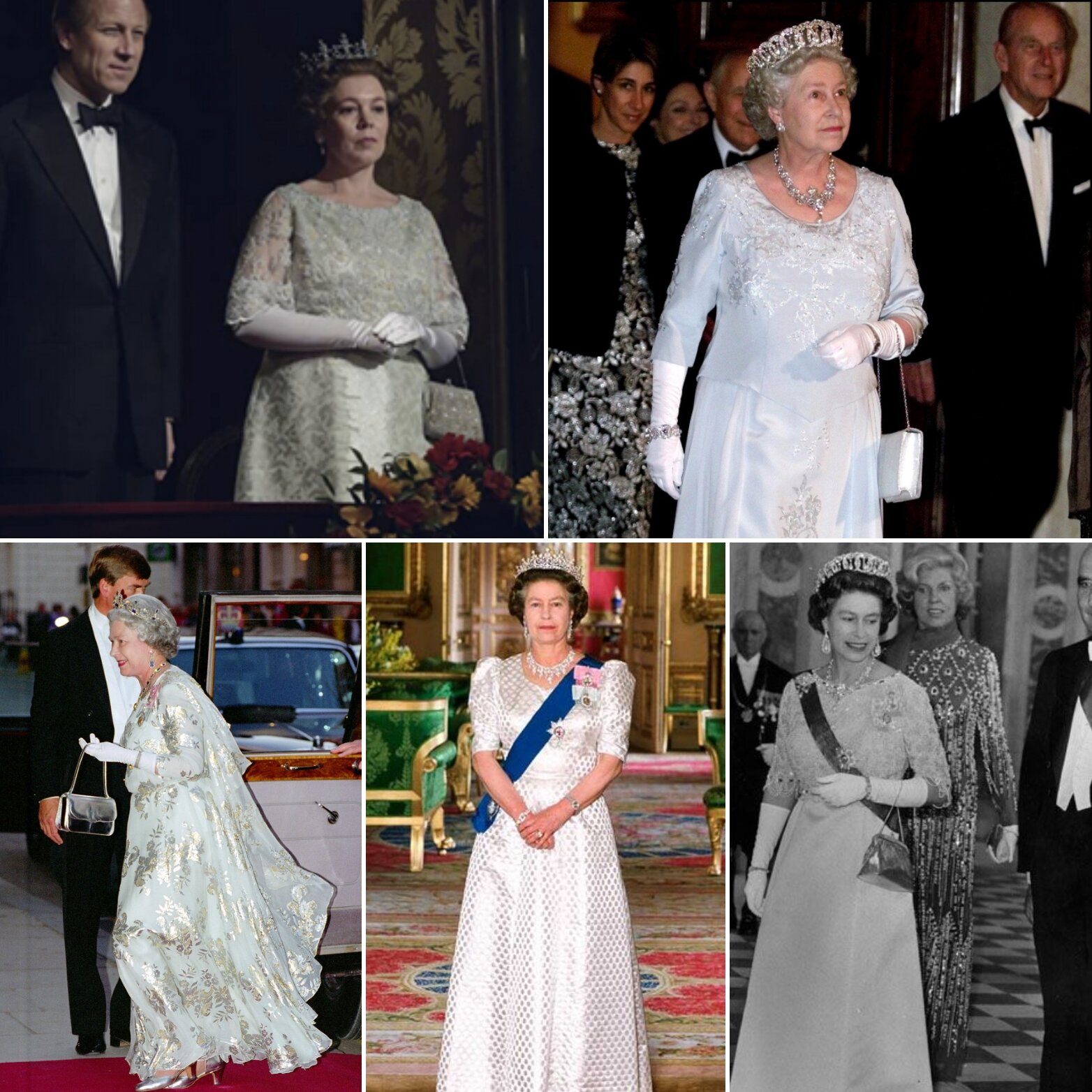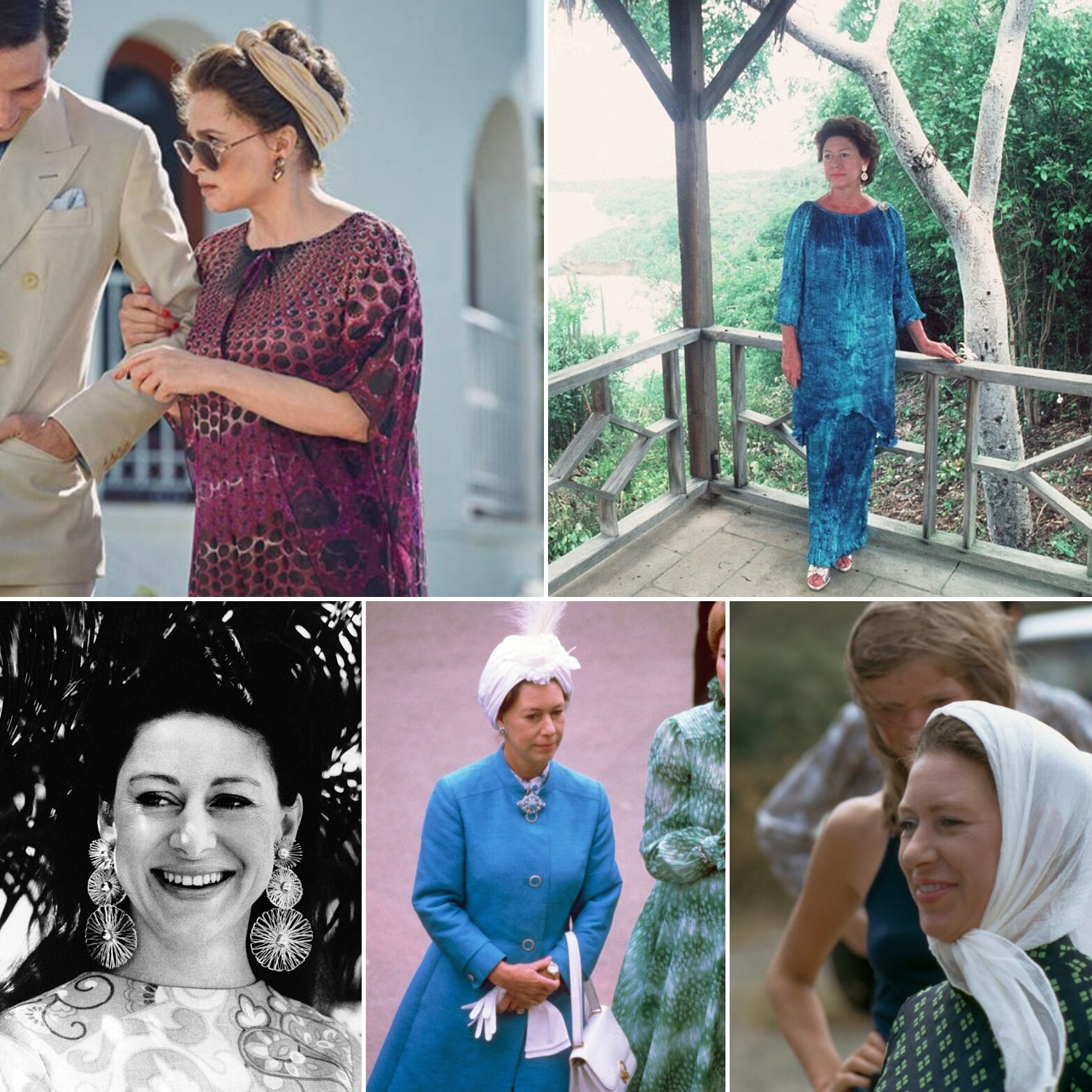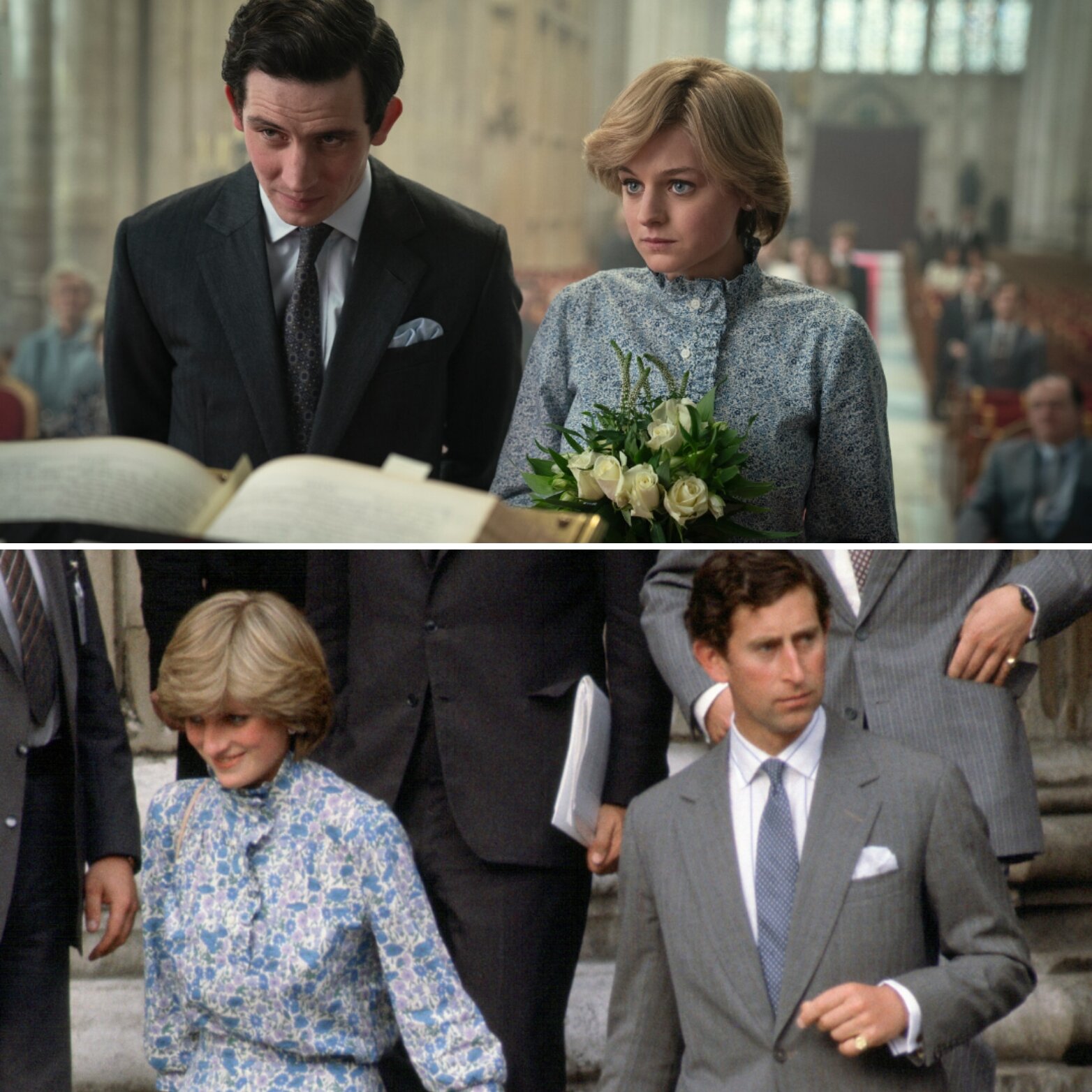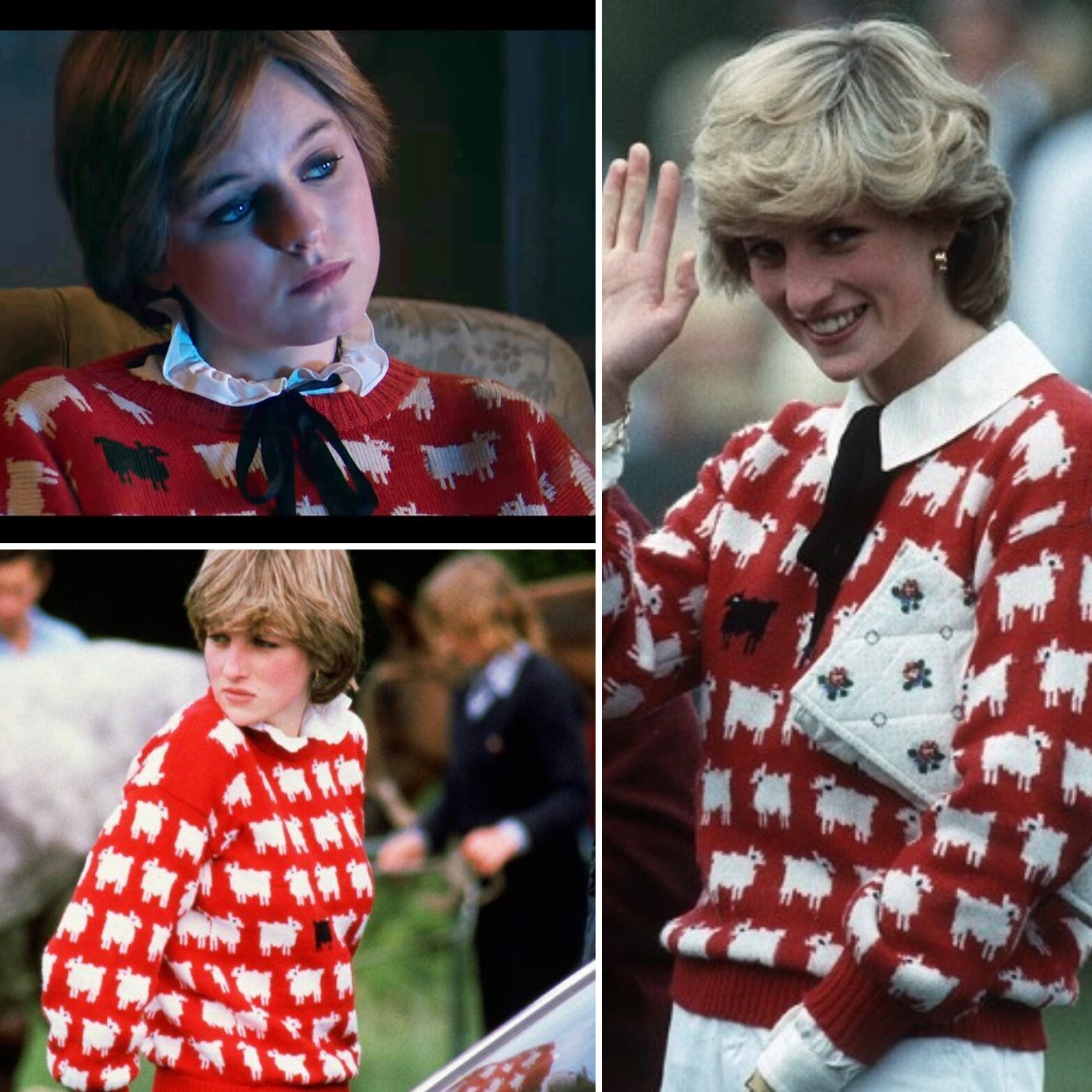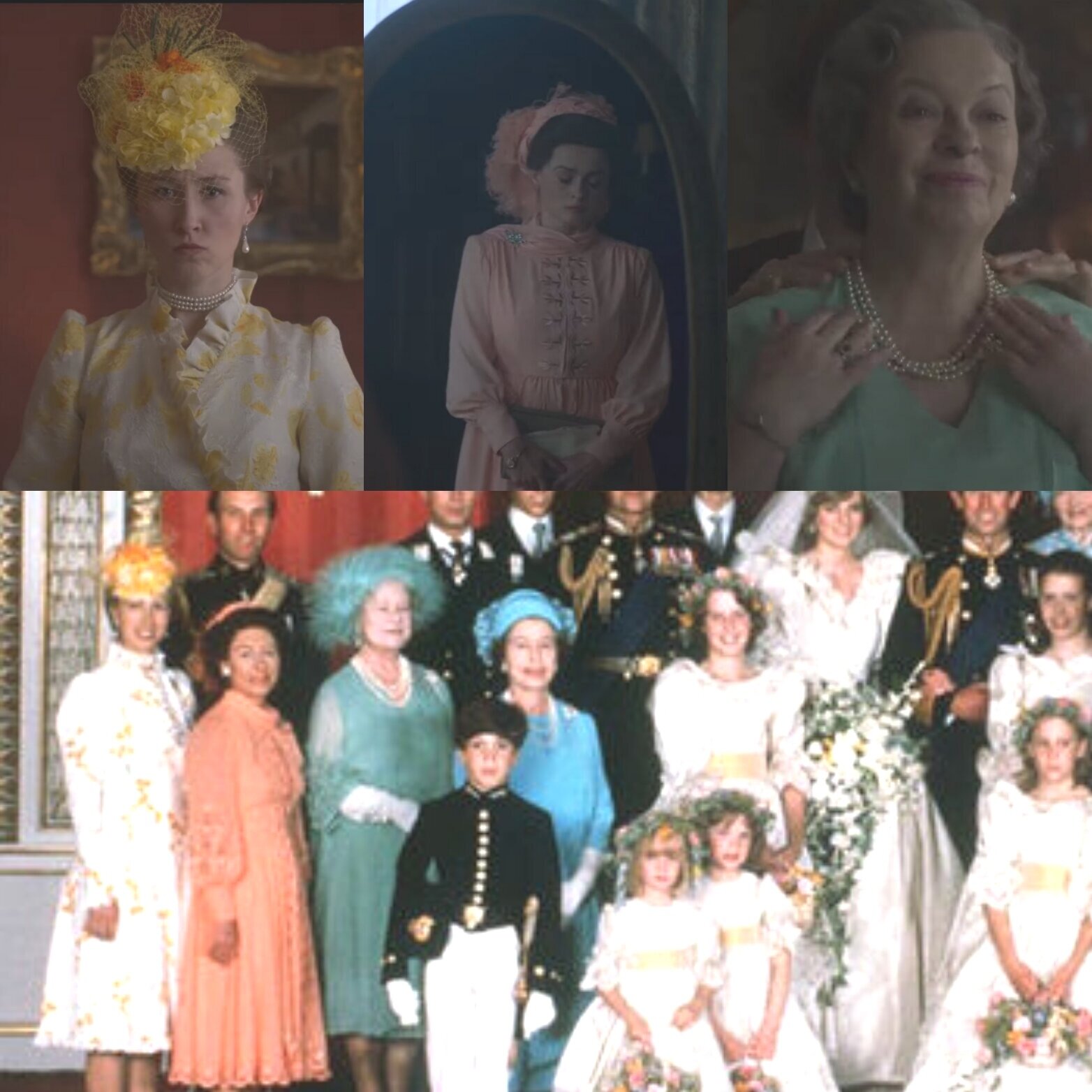As he rides his bus past Buckingham Palace on the way to the job center, “Boys Don’t Cry” by The Cure plays in the background. This 1979 post-punk/new wave song likely came out when Fagan was still doing well, living with his wife and kids, and working regularly. The lyrics are very on point here, as the song talks about a man who has given up trying to regain his lost lover and hides how sad he really is. Similarly, Fagan’s wife has left him, but he makes no attempt throughout this episode to try to win her love back; his focus is, instead, seeing his children. The music in this episode is really important, as the songs are almost entirely modern rock/punk songs about male disillusionment and sadness. We haven’t heard songs like this in the show before, as we haven’t focused on a commoner male character before like this, who’s at such an incredibly low point in his life. I feel like the most similar situation we’ve seen to this before is when we saw Princess Margaret breaking down in S2E4 Beryl to “Angel Eyes” by Ella Fitzgerald, but even that is from a specifically female point of view.
Fagan wears essentially the same outfit the entire episode, a distinctive dingy green and red coat over various blue shirts, which looks VERY MUCH like a coat the real life Fagan wore. If you pay attention to this episode, you’ll see that the background in both the estate and Buckingham Palace shows a lot of red and green; the Queen wears a lot of red, green, and blue as well. This seems to illustrate both their similarities and their differences.
The job center is super crowded with long lines of people who look similarly tired and dispirited. He’s here to collect his jobseeker’s allowance, which is available in the UK to adults who are unemployed and actively seeking work. To get the benefit, the jobseeker must appear at the center in person every two weeks to certify that they are still actively seeking work. This is actually still the policy in the UK, but because of the Covid-19 pandemic, those receiving jobseeker’s allowance have been excused from sign on attendance since March 2020.
Fagan gives a lot of cheek to the woman at the job center about how she asks him the same thing every two weeks and how she should know who he is now, but tbh, I just feel sorry for her. She probably deals with hundreds of people a day and couldn’t possibly remember them all. It is a bit ironic that he jokes about how he worked with the Olympic Committee and the United Nations, as that is TOTALLY the type of people we would normally see on The Crown. This intense focus on the real world away from the royals and the top echelons of power is new to the show, except for a few episodes that focused on specific disasters affected the common people, like the smog in Season 1 and the Aberfan disaster in Season 3.
The rest of Fagan’s day is dedicated to working a “cash in hand” job painting a room, where he quips that the paint color “beige 28” is the color of his life. Conveniently, he’s wearing a beige shirt when he says this. Afterward, he goes to a pub, where he clearly is looking out for his wife. He tries to talk to her about their flat (we find out later that she’s the listed tenant on the flat, so he can’t get any money to fix up the flat without her involvement), but she brushes him off, saying tonight. She also brushes him off when he asks about the kids. This brush off frustrates him and he takes out his anger on her new boyfriend, calling him a Twat. His wife and her new boyfriend both throw the fact that the new guy works for a living and looks after his kids in Fagan’s face, which angers him even more. who taunts him by saying he’s the one who’s caring for Fagan’s children. This almost escalates into a fight, but bystanders manage to pull the men apart before they actually come to blows.
This sequence ends with the ska song “Monkey Man,” a cover by The Specials (originally by Toots Hibbert of Toots and the Maytals). A Monkey Man, according to the Oxford Dictionary, is “a weak or gullible man, especially one subservient to women generally.” This ties in with Fagan’s feelings of helplessness about his life, particularly when it comes to his family. The songwriter has said that the song was actually inspired by a girl he loved who left him for another man, which is…very on point for the situation.
The shots of Fagan’s housing estate, complete with bars at the windows, switch quickly to the metal Buckingham Palace gate - once again juxtaposing the upper class royal setting of the Palace with Fagan’s lower class, realistic life. The director of the episode said on the Crown podcast that he really wanted to make it clear when the episode was in “Faganland,” quipping that Faganland is also known as “real life.”
In the Queen’s regular audience with Thatcher, Thatcher’s in her power blue color and the Queen is in a lighter blue (once again matching Fagan’s usual colors- this will happen throughout the flashback in the episode). Thatcher brags a lot about the war in the Falklands.
In the next scene, the Queen and Philip are walking to an event together (past some bright yellow flowers that are reminiscent of Fagan’s sad yellow floral comforter), and Philip notes that they should “roll out the red carpet” for Margaret Thatcher, as she pushed ahead with the conflict in the Falklands even when no one else supported it, and it’s turned out to be a huge success. “She’s finally doing what we’ve been waiting years for someone to do …lead this country firmly and decisively after years of incompetence and mismanagement.” The Queen also complains that Thatcher brought up palace security again, which angers her, saying “Do you want our walls to be built even higher? Or the public to stand ten feet further back at engagements.” This foreshadows Fagan’s break-in to the palace while also establishing the theme of the Queen’s need to meet regular people.
The Queen says, “I take great pleasure in meeting members of the public and have learnt so much from them. You remember the lesson Lord Altrincham taught us.” They meet up with Princess Margaret and the Queen Mother at a Garden party, where they meet “regular people.” This hearkens back to S2E5 “Marionettes,” in which Lord Altrincham criticized the queen in his newspaper and advises her to become more transparent and inclusive of regular people. The Garden Parties replaced debutante presentation parties (which were only reserved for the very rich and noble) and are still held three times a year at Buckingham Palace and once a year at the Palace of Holyroodhouse in Scotland (although they were cancelled this year due to COVID-19). You can see that the Queen IS really trying to reach out to her people, but as becomes apparent throughout the episode with the juxtaposition of her life with Fagan’s, she’s still incredibly out of touch with the lives of regular Britons. It’s also rather funny that they all put on gloves before shaking hands with the regular people, as if they don’t want to actually touch any commoners.
Princess Margaret cares far less about meeting regular people than the Queen and specifically checks with Martin Charteris that they don’t have to have actual conversation with anyone. Margaret’s dislike of the whole thing was also demonstrated in the earlier S2E5 episode, in which Margaret complained to Philip about meeting commoners. In that episode, we also saw that the Queen Mother didn’t particularly like the idea either, but she is silent here. Ironically, Margaret wears drab green and red, matching Michael Fagan’s outfit most closely, but I think the use of the colors is juxtaposed to show their differences here, not their commonality. The royal band is also wearing red uniforms and green hats, which again, matches
The lines of colorfully dressed, respectable, happy commoners at the garden party eager to meet the royals contrasts sharply with the drab despair of the unemployment line at the job center. Thatcher’s voice echoes over the radio in the background (in a distinctly dystopian way, although this of course, is just from a radio broadcast); she’s talking about her up-bringing “we were taught to work jolly hard. you were taught to improve yourself. you were taught self-reliance.” This is a pretty tone-deaf message when there are clearly no jobs to be had for so much of the country. As Fagan said in an earlier scene, everything in here feels pretty beige and dull and dreary. Fagan is again back here to collect his check, and quips sharply to the worker that he works as james bond, who (quite rightfully, in my opinion), calls him a twat. He asks who he can complain to, and she says he should go contact the MP, who can contact the parliamentary ombudsmen. This is ultimately the comment that sets his whole plot in motion. The worker then shuts the window in his face, which seems symbolic of a lot of the bureaucratic obstacles he’ll face in this episode.
We get another shot of Fagan in his sad, empty apartment, watching footage of a military parade on TV and listening to Thatcher speaking on the radio, defending her economic policies again by describing her actions as some sort of tough life.
Fagan’s next at his MP’s office; he’s waiting for him to arrive because frankly, he doesn’t have anywhere else to go. He tries to talk to the MP “about the system,” calling it “unfair and a disgrace.” He calls Thatcher “devil woman” and complains that he doesn’t have any work to do because she’s spending money on the war instead of using it to build houses he could paint and decorate. The MP seems rather stand-offish from the beginning, insisting that he supports the war and not really listening to Fagan’s concerns. Fagan lays out his central frustration in a simple question: “Why would you spend over three billion pounds on a war against total strangers rather than looking after your own family?” This points to his views of the country as a family and as its responsibilities to its citizens.
Fagan calmly points out that the MP hasn’t actually noted his concerns, and hasn’t taken any notes the entire time, and ultimately forces him to write down /something/. Fagan says that having Thatcher’s picture in the office makes it feel like “we’re in turky or iraq,” which adds to the previous dystopian like feel of Thatcher’s voice over the unemployment line.
Finally, in frustration, after a few minutes of arguing about the workings of democracy, the MP tells Fagan that the Queen has a private audience with Thatcher every Tuesday and quips, “Why don’t you drop in at Buckingham Palace and tell her? “
And we’re back to the Trooping the Color, which we saw previously in S4E1 Gold Stick. This shows the passing of time, the Queen taking the salute from her troops (which we’ll circle back to later), and refers to various lucky members of the public getting to attend the event, again illustrating the royal family’s attempts to connect to the public and ultimate failure at doing so.
Then a sharp cut from the “regular people” at the trooping the color, sitting in rows watching the event, to people waiting in rows at the social services office. Again a cut from bright outside light and music to a drab, dreary office setting. Fagan’s in a terrible situation here, we find - as Social Services won’t let him see his children until he fixes up the water damage in the flat, he can’t get money or help to fix the flat from the Council or social services because he’s not listed as the primary tenant on the flat, and his wife, who IS the primary tenant of the flat, won’t talk to him about it (as we’ve already seen happen in the pub). So he’s completely prevented from seeing his children at all. The office worker tells him he needs to talk to the estate council, but as Fagan has already told him, the council pointed him to social services, so he’s left without anyone to help him.
On his way home on the bus, he passes by Buckingham Palace and abruptly gets off, looking up at the palace through the barred gates. He then manages to get in by jumping over the fence, climbing up a drain pipe, and crawling through an unlocked window. He sees a few guards but manages to avoid them pretty easily. He then basically just wanders around the palace, trying various door handles and even sitting on the throne at one point. He enters a room full of gifts (notably with a portrait of the queen there, staring at him) and downs half a bottle of wine pretty quickly, managing to knock over a vase in the process. He manages to get into the Queen’s bedroom, but it’s empty. Eventually, a maid sees him and rushes to the security office, sounding the alarm.
Fagan really did sit on the throne. He said in an interview with The Independent in 2012, “It was like Goldilocks and the Three Bears; I tried one throne and was like 'this one's too soft'. I was having a laugh to myself because there was one right next to it, so I tried another.”
The creators of this episode said on The Crown podcast that it was kind of unbelievable how easy it was for Fagan to get into the Palace, and that if it HADN’T happened in real life, no one would believe it.
If you’ll note, the carpet throughout Buckingham Palace is red, calling back to Philip saying they should roll out the red carpet for Thatcher.
Fagan wasn’t the first intruder at Buckingham Palace. A young teenager named Boy Jones repeatedly broke into the palace to stalk Queen Victoria, stealing the queen’s underwear and food. He kept breaking in even after being imprisoned for three months, and eventually was deported to Australia.
The entire sequence where Martin Charteris reports on the break-in to the Queen and Philip is pretty funny. Philip laughs at the intruder’s drinking a bottle of wine valued at six pounds. Philip is also very proud of remembering the vase that was broken, describing it as “a ghastly little pink thing with little blue worms all over it” and “a strange-looking duck.” The Queen quickly corrects him by noting the exact symbolism of the vase, naming the rivers of guyana and the national bird present on it, which is pretty damn impressive considering how many gifts she must receive every year. Her private secretary looks at her with pride over her recall of these little details.
Fagan manages to make his situation worse when, after watching his kids play on a playground with his wife’s boyfriend, he jumps over the playground wall and tries to speak to his wife. The wife and boyfriend quickly motion the kids away, which seems only to enrage Fagan. The fight that almost happened at the pub earlier in the episode now actually happens on the playground, resulting in the boyfriend putting Fagan in a chokehold. Fagan leaps back over the wall (similarly to how he got in and out of Buckingham Palace the first time) and runs away, as his wife yells “Are you proud of yourself? Leave us alone. We don’t need you in our lives.”
The incident at the playground results in a meeting with social services, who says Christine will have permanent custody of the kids and Fagan can’t have any contact with his kids, for their best interest. He doesn’t say anything in response but just looks distraught.
What do they know about Fagan that we don’t? Do they perceive him as dangerous to the children? I really haven’t found much information on Fagan’s family life. All the sources seem to confirm that his wife Christine had left him, taking their four children with her, but I can’t find any explanation of why.
After the fight, “Twenty Four Hours” by Joy Division” plays in the background, specifically - the lyrics “A cloud hangs over me, marks every move Deep in the memory, of what once was love.” This very sad song, which was recorded just over a month before the band’s frontman Ian Curtis committed suicide, talks about everything in the singer’s life slipping away from him.
In real life, Fagan was much more of a piece of work than he’s portrayed as in the series. He complained about his portrayal in The Crown, saying that they made him appear ugly and uncharismatic, but I’m really not sure why, as they actually made him appear sympathetic. In reality, he actually visited Buckingham Palace 12 times in the summer of 1982 and told his mother that he was visiting his girlfriend “Elizabeth Regina,” indicating a far more intense obsession with the Queen than was shown in the episode. Fagan himself told the Independent in one article that he couldn’t find a bathroom and ended up peeing on the corgi food. After his first break in to the palace, he actually was arrested for stealing a car (he was apparently trying to drive to stonehenge in search of his wife. was his wife in stonehenge? i don’t know. maybe it made sense in his head). He also claimed that the entire decision to break into the palace was the result of a prolonged reaction to taking too many hallucinogenic mushrooms several months before.
After the devastating social services meeting, Fagan returns to TV reports showing that the UK has won the Falklands war. Notably, the news reports that the queen has returned to Buckingham Palace. He looks out from his balcony incredulously, as all around his estate, people are celebrating the victory in the Falklands, singing “Rule Britannia” and chanting “Maggie Maggie Maggie! Oi Oi Oi!”
Next we see the Queen going about her evening in a very prosaic series of scenes. She watches the news eats dinner alone while wearing green, then gets ready for bed, wearing a blue and white floral robe and matching nightgown. We notably see her praying at her bedside; her faith hasn’t been discussed much in Season 3 or 4, nor has it really been addressed much since Billy Graham’s appearance in S2E6 Vergangenheit, but little moments like this do remind us that she is a Christian and takes her religion quite seriously.
Meanwhile, Fagan breaks into the palace again, somehow avoiding guards as they change shifts and breaking a window to get in.
In the show, a maid walks past carrying a vacuum and later is shown vacuuming the carpet. I’ve seen people complain on Facebook groups and such that this is inaccurate, as there are some reports online that housekeepers are not allowed to use a vacuum in Buckingham Palace. However, The Atlantic reported that Buckingham Palace had a vacuum cleaner as early as 1902, which seems to contradict that report. In addition, The Crown actually has their own royal protocol advisor, Major David Rankin-Hunt, who worked for the royal family for 33 years. He’s very active in the show and often corrects things on screen that aren’t accurate for the royal household, like folding in people’s pocket flaps and making sure their umbrellas are wrapped tightly enough and such. Since the vacuum cleaner is literally a plot point in the script (as it keeps the maid from hearing the Queen’s bell), I find it really hard to believe that Rankin-Hunt would overlook such a big thing if vacuums were really banned in the palace. It’s hard to know though.
The floral floor-length nightgown matches Fagan’s description of her outfit in real life: “Her nightie was one of those Liberty prints and it was down to her knees." This refers to a clothing brand called Liberty known for using floral prints.
As Fagan enters the queens’ bedroom, the queen sleeping says “morning bobo.” This refers to the Queen’s long-time dresser, Margaret “Bobo” Macdonald” who actually served her first as her nanny (which reminds me very much of Queen Elizabeth I’s relationship with her governess Kat Ashley, who rose to become her chief lady in waiting). We saw Bobo in the background a few times in Season 1 and 2, but the IMDB cast list for the show doesn’t show anyone playing that role in Season 3 or 4.
It’s been really confusing trying to sort out all the different stories about this that Fagan has given over the years, so I honestly just started to look at the police report to figure out what happened.
The police report from the time said that Fagan initially got into the palace by climbing over the railings and entering an unlocked window to a room which housed “the Royal Stamp Collection.” All the doors in that room were locked, so he quickly left it through the same window. He then climbed a drainpipe to get to the roof, took off his sandals and socks, and climbed across a narrow ledge to get through an unlocked window in an office of the master of the household which had just been opened for the day by a housemaid. He wandered around the palace for 15 minutes or so without being challenged by anyone. *In the show, the window was locked the second time and he had to break it to get in.
The police report notes that Fagan claimed to find his way to the queen’s apartments by “following the pictures.” In an anteroom of the bedroom, he smashed a glass ashtray and brought it with him, intending to slash his wrists in front of her. AGAIN, the show clearly makes him seem much more sympathetic than he was in real life. In the show, his bleeding hand is the result of his breaking the window to get in, rather than breaking an ashtray or slicing his own wrists.
In both real life and the show, Fagan opened the curtains upon entering the bedroom. In the show, he prevents her from calling for help, but in real life, she immediately pressed the night alarm bell (this is about 7:15 am). This unfortunately, occurred right after her police sergeant (who’s in the corridor at night) had just gone off duty; this is reflected in the show when Fagan says that there isn’t any officer outside of the room. There were a few servants on duty already. However, the footman who was outside walking the dogs and a maid was cleaning in another room with the door closed. Thus, no one actually noticed the night alarm bell at first. In the show, the maid doesn’t hear the bell due to the sound of the vacuum.
The Police report (which notably doesn’t say what Fagan is doing during this time) notes that the Queen next used her bedside telephone to ask the palace telephonist to send the police to her bedroom. The telephonist called the police lodge at 7:18 am. At 7:24, the Queen called again for help, as a police officer still hadn’t arrived. She eventually elicited the help of a maid, who helped her usher Fagan into a nearby pantry on the pretext of getting him a cigarette. At this point, the footman returned from walking the dogs and helped keep Fagan there by supplying him with cigarettes. The Queen “kept her dogs away as the man was getting agitated.” Eventually, a police officer arrived, and then another, and they took him away.
The show’s depiction of events diverges sharply from real life at this point. In the episode, the queen and fagan talk for a bit until she points out that he’s bleeding. As he goes to the powder room to clean up his cut, she rings the alarm bell, without any response. She tries to pick up the phone, but he comes back in the room before she can actually call anyone. They end up talking for several more minutes before a maid comes in with the tea and asks the queen if she’s alright (Major kudos, by the way, to the maid, who somehow doesn’t scream or drop the tea or anything). The queen responds calmly, “Yes, quite alright. But you might ask the policeman to come in."
The show DOES reference the whole cigarette trick by having Fagan ask the Queen for a cigarette.
I actually honestly wish they had followed the real life story a little bit closer, as I would have loved to see the queen trick Fagan into going to a pantry and protect her dogs from him. This show ALWAYS needs more corgis, In My Opinion.
The little scene between Fagan and the Queen in the bedroom is very well written and very sad. He says he wants to talk to her about what’s going on in the country, and that she hasn’t any reason to fear him. I’m not going to analyze the substance of their conversation too much, but it’s a really beautiful scene that ultimately brings out the queen’s compassion and sympathy for his plight. He begs her to “save us all” from Thatcher and says that she can actually do something. However, as we’ve seen emphasized throughout this show, the Queen really doesn’t have any power in political situations like this and can’t really do anything to help him besides talk to Thatcher, which ultimately does nothing.
Fagan comments that the palace is somehow “posher than you’d think but yet more run down,” as it has chipped paint, peeling wallpaper, and stains everywhere. He made a similar observation in an interview, stating, “It was very ordinary. I don't think they spent too much on decoration. Maybe it was due a redec?"
Within the scene, Fagan shows off his intelligence, noting that the palace is actually public property and that trespassing isn’t a crime if he doesn’t steal anything. At the time, trespassing was a civil offense, not a criminal one. He was not charged with trespassing, apparently to avoid having the queen come and testify against him.
There’s a very funny moment where Fagan says that Thatcher will put the Queen out of a job next; the queen dryly responds “Let me assure you; she is in an all too committed monarchist,” perhaps thinking of Thatcher’s obsequious curtsies to her.
The Queen tries to reassure Fagan by saying “Countries bounce back. People do. Because they have to. One of the most well crafted lines has Fagan saying, “First the work dried up, then my confidence dried up. Then the love in my wife’s eyes dried up, then you begin to wonder you know, where’s it gone, not just your confidence or your happiness…(trails off). They say I have mental health problems now. I don’t. I’m just poor.” As he continues, the Queen sits across from him naturally, a subtle reference to her regular audiences with the prime minister.
The Queen ultimately ends up connecting with him and slightly defending him from the officers. Their conversation ends this way:
Queen: "Is there anything else you'd like to say to me?"
Fagan: "No. Thank you.”
Queen: "I do hope they don't make things too difficult for you, in light of all this."
Fagan: “Thank you."
Queen: "Well, goodbye." (Fagan stands and reaches out his hand to shake hers)
Officers, barreling through the door to come help: "Don't touch her!"
Queen: (to officers) “It's alright.” (she shakes Fagan’s hand) “I will bear in mind what you've said."
The handshake with Fagan, with bare hands and no pretense, thematically ties back to the earlier handshakes at the garden party, when everyone was wearing gloves and on their best behavior.
Olivia Colman does a great job of looking absolutely petrified of him initially, but in usual queenly fashion, quickly regains her composure as she speaks to him calmly. Her fear is only again evident at the very end of the scene, when after Fagan is taken away by the police and she’s finally alone again, she falls back into her chair, gasping and eyes tearing up, looking completely drained.
Then we’re back to where the episode started, with the news reports about Fagan’s break in. Margaret Thatcher watches the news with several stone-faced advisors, looking very distressed.
The episode makes it look like the final days of the Falklands War happened right when Fagan broke into Buckingham Palace, but that’s not quite true. Fagan’s first break into the palace was in early June 1982 and his final entry was on July 9. The British managed to retake all the islands on June 20, a few weeks earlier.
I’m really not talking about the war too much because I honestly don’t know much about it and I don’t want to be run out of Argentina in the future if I get something wrong. However, I do want to note that although Thatcher said in her first audience in this episode that there were no British casualties in whatever specific operation she was talking about, there were actually casualties on both sides of the war. Casualties included 255 British service members, 3 female British civilians of the Falkland Islands, 633 Argentinian service members, and 16 Argentinian civilians. The servicemen on both sides came from several branches of the military, including the Army, Navy, Marines, and Air Force.
The Queen does try to speak to Thatcher about Fagan, noting that he is a victim of unemployment and economic problems, which are not his fault, but ultimately is unsuccessful. Thatcher describes the high unemployment as “a necessary side effect of the medicine we are administering to the British economy” and dismisses the Queen’s questions of moral economy by saying, “If we are to turn this country around, we really must abandon outdated and misguided notions of collective duty.” *NOTE: I am only talking about the portrayal of Margaret Thatcher in this show; I have not done in depth research into her real life views on people. I do plan to read her biography in the future and go back and supplement these posts then, but unless I actually say “in real life” or something equivalent, I am always talking about the characters in the show and not the real people.
This line demonstrates that in her own way, Thatcher does care about the “common man” as much as the Queen, just in a very different way. When the queen notes, “Perhaps not everyone is as remarkable as your father,” Thatcher stoutly responds, "Oh you see, that is where you and I differ. I say, they have it within them to be." When the Queen brings up Fagan, Thatcher notes that he’s another matter, as he’s been diagnosed with mental illness and schizophrenia. She then quickly excuses herself, as she needs to go to the victory parade (which the Queen was notably not invited to).
This scene is set up to emphasize the distance between the Queen and Thatcher in these audiences, which is the same it’s always been, but looks further apart then ever, when compared to how close the Queen sat to Fagan during their conversation.
Later on, while watching the victory parade on the television with her husband (both of them dressed in similar shades of brown and grey), Elizabeth comments on Thatcher taking the salute from the troops instead of the sovereign. This did happen in real life and raised some eyebrows at the time. In 1945, after World War II, King George IV took the salute from the troops rather than Winston Churchill.
As the royal couple talks comfortably, Philip refers to Fagan as a lunatic and a fool. The Queen counters, “but in the best sense, like Lear’s fool.” Philip responds grumpily “Don’t get all Shakespearean with me.” This is a reference to a character in King Lear, which has a couple of interesting layers to it. In the time of Shakespeare, leaders often had fools, or court jesters, to amuse them. They played an important role though, as they are able to speak truth to power and confront their leaders in ways that no one else can. In addition, fools in that time often had mental illnesses, and were considered blessed by God. Within King Lear specifically, the fool serves as the king’s advocate but also his conscience, critiquing Lear’s faults. All of this is a very apt description of Michael Fagan, who has a mental illness and simultaneously served as the Queen’s advocate and critic.
We have one of the first really emotional moments this season from Philip when his face breaks apart a little and he says, “I’m sorry that I wasn’t there to protect you. I feel terrible.” The Queen reassures him in a very loving way, saying “but you're by my side all the time and do much more than keep me safe. but thank you.” They then exchange another quietly funny moment, as she observes, “I suspect Mr. Fagan is rather glad he didn't come through that window and land on your bed.” Philip laughs quietly and responds, “Yes, that would have been a rather different conversation.”
The show ends with a final look at Margaret Thatcher on the TV screen, waving happily to the crowd at her victory parade. The Queen looks at her with clear concern.
The credits run to the 1980 ska song “Whine and Grine/Stand Down Margaret” by The English Beat, which is specifically about the band wanting Margaret Thatcher to resign. At the time it came out, Uncut magazine described the song as “polite insurrection set to uptempo reggae and African hi-life guitar,” which is flipping amazing.
As the explanation in the credits says, Michael Fagan was committed after his arrest. He only spent three months in the psychiatric hospital. The second photo in the credits shows Michael Fagan saluting alongside four men; they don’t explain this in the show, but this actually shows Fagan with The Bollock Brothers. Fagan recorded a cover of The Sex Pistols’ “God Save the Queen’ with this punk band in 1983.
Over the years, Fagan has continued to distinguish himself with various petty crimes. He was notably imprisoned for four years in the late 90s after he, his wife, and their (now-adult) son were charged with conspiring to supply heroin. He lives in London now,


